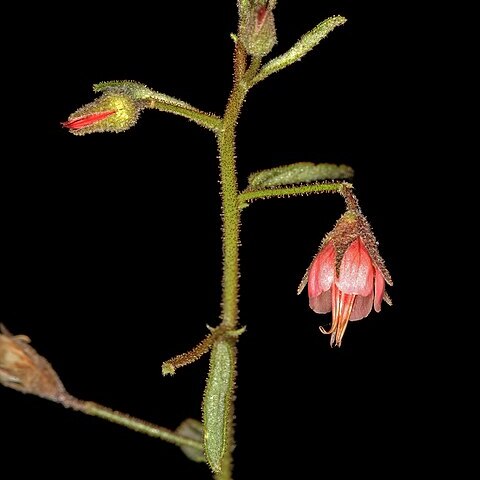Bushy suffrutex, 0.2-0.4 m long; fairly densely hairy with stalked glands intermingled with bulbous-based, stellate hairs and a few, simple, patent hairs. Leaves elliptic, oblong or obovate-oblong; acute or broad at apex, 3-toothed. Stipules subulate. Inflorescences axillary, 1-flowered; peduncles 6-22 mm long; pedicels pubescent as above. Flowers ± 10 mm long, pink or off-white. Calyx lobed to beyond middle; stellate hairs basally, fairly densely hairy with stalked glands intermingled with bulbous-based, stellate hairs, margins outlined by simple, white hairs. Petals shorter than calyx, oblong-cuneate. Flowering time June? Fruit: apex of capsule with 5 pairs of horns up to 2 mm long.
Leaf-lamina up to 3 × 1 cm., narrowly oblong to obovate-oblong or elliptic-oblong, apex obtuse or acute, margin serrate, at least towards the apex, base cuneate or rounded, thinly stellate-pubescent and glandular above, more densely so beneath; petiole up to 7 mm. long, glandular and stellate-pubescent; stipules c. 1 mm. long, deltoid-acuminate, glandular and stellate-pubescent.
Suffrutex, up to 200 mm tall. Branchlets mainly appressed stellate-pubescent. Leaves elliptic, oblong or obovate-oblong, up to 27 x 14 mm. Inflorescence axillary, 1-flowered. Capsule densely stellate-pubescent all over. Flowers pink, mauve or purple.
Flowers on 1-flowered thinly stellate-pubescent and glandular axillary peduncles up to 1·5 cm. long; pedicel similar, 2–4 mm. long; bracts like the stipules.
Stamens with narrowly obovate filaments, c. 3·5 mm. long, pilose on the shoulders; anthers c. 5·5 mm. long, purple, connivent, exserted, pubescent.
Perennial herb or shrublet, up to 0·6 m. tall; branches pubescent with glandular hairs often mixed with longer stellate hairs.
Calyx c. 7 × 5 mm., campanulate, stellately pubescent with some glandular hairs; lobes c. 5 mm. long, narrowly triangular.
Petals c. 5 × 2 mm., pink, oblong-obovate, margins inrolled in the lower third, pubescent within the inrolled portion.
Capsule c. 8 × 5 mm., oblong-ovoid, truncate at the apex with 5 spreading horns 2 mm. long, tomentose.
Seeds dark brown, c. 1·5 × 1 mm., reniform with radiating wrinkles; testa minutely granulated.
Ovary obovoid-oblong, tomentose; styles c. 4 mm. long, pubescent except near the apex.

